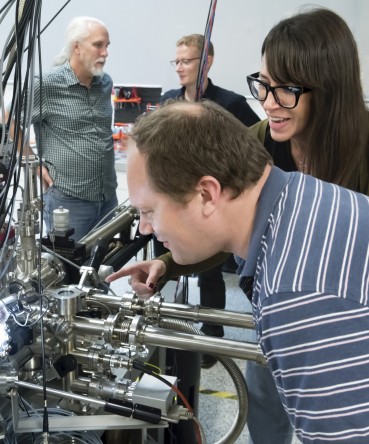FLEET collaboration - Annual Report 2019
13 March, 2020
Laying the groundwork for a low-energy computing revolution
When Microsoft chief executive Satya Nadella visited New Zealand in November he left his audience with some jaw-dropping statistics to illustrate the exponential growth in computing the world is experiencing.
By 2025, he told business and technology leaders in Auckland, 175 zettabytes of data will exist in the world (one zettabyte is a trillion gigabytes). By 2030, there would be 50 billion connected devices.
That presents one big problem for Microsoft and the other companies that increasingly host the bulk of our information in massive data centres scattered around the world - more computing power means more energy consumption.
8 percent and rising
Computers already account for 8% of global electricity consumption, a figure set to increase rapidly given the hyperconnected nature of the world.
“The bigger part of the problem is how quickly that number is growing,” says Dr Simon Granville, MacDiarmid Institute Principal Investigator and Senior Scientist in the Robinson Research Institute.
“If some new technology could stop the growth in the amount of electricity being used while allowing conventional computing to become more and more available, the benefits of this large scale computing would be achievable without bankrupting the world.”
While many researchers are looking to extend computing power as Moore’s Law starts to run out of steam, a trans-Tasman research collaboration is instead focused on solving the energy issue.
Formalising a rich and ongoing relationship

In 2019 the Monash University- based Centre of Excellence in Future Low-Energy Electronics Technologies (FLEET) and the MacDiarmid Institute established a new partnership between the two science organisations, which share a mission to search for future low-energy electronics via the development of novel materials and devices.
One early partnership project aims to produce a new, low energy version of the silicon-based transistor, which has underpinned the computing revolution to date.
“The transistor is a switch that can be turned on and off to allow a current to flow. It’s basically how we do most electronics,” explains Victoria University of Wellington Professor Michele Governale, a Principal Investigator at the MacDiarmid Institute.
Beyond the transistor
“In order to open and close the switch and run current through it, we use power. What FLEET wants to do is substitute the building block, the transistor, with something that is low power.”
The answer may lie in developing materials with electrical and thermal properties that go beyond what is possible with transistors on silicon-based chips when it comes to power efficiency - and to be able to do it at room temperature, rather than relying on energy-intensive cooling systems.
The MacDiarmid Institute’s team of theoretical and experimental physicists are studying the nature of these ‘topological’ materials, which could coat a future generation of transistors.
“They have what we call 'surface states',” says Professor Governale. “You can have transmission without energy dissipation, effectively zero resistance. We've done a lot of theoretical work on these materials and how their surface states change.”
Thin magnetic coatings
 “What happens when you make them smaller and smaller? Will they still have that surface state or will it be destroyed?”
“What happens when you make them smaller and smaller? Will they still have that surface state or will it be destroyed?”
Dr Granville is setting out to answer that question in his lab, where he is experimenting with thin coatings of materials using a range of magnetic materials called Heusler alloys, which could optimise transistors for low- energy operation.
“The next step is to make very simple devices in the lab (big ones you can see, rather than tiny transistors), to try and prove you can use them as a switch,” he says. “At that point, you might get some idea of how much energy you could save.”
Partnering with FLEET allows the MacDiarmid Institute researchers to combine their nanoscale materials expertise with the Australians’ knowledge of advanced electronics design.
There are many technologies in the running to replace conventional transistors, from the topological materials that are the focus of the MacDiarmid Institute researchers, to superconductivity, quantum computing and even neuromorphic computing, which mimics the circuitry of the nervous system.
“Some are so radical that the only way you'll get anywhere is through these small research collaborations, rather than a large company throwing a lot of money at a problem and putting their own lens on it,” says Victoria University of Wellington Professor, Uli Zuelicke, who has been a Principal Investigator of the MacDiarmid Institute since 2004.
“It is like quantum computing. For years it was the domain of the universities. Now it has moved into the realm of big companies like IBM, Google and Intel,” he adds.
In October, researchers from the MacDiarmid Institute and FLEET gathered outside Trieste at the home of the UNESCO-sponsored Abdus Salam International Centre for Theoretical Physics (ICTP).
As well as attracting some of the top physicists from around the world, the conference was fully funded by the International Centre for Theoretical Physics (ICTP), which allowed FLEET and the MacDiarmid Institute to contribute their own funding towards sponsoring scientists from developing countries to attend.
Such efforts to share knowledge and foster collaboration will be crucial to solving the growing sustainability issue presented by the world’s insatiable demand for computing power.
“MacDiarmid is known for this connectedness internationally,” says Dr Granville.
“The Government views international collaboration as a priority and the work we are doing with FLEET is a big part of that.”
As well as opening up opportunities for PhD and post- doctoral researchers to participate in projects and work at each others’ labs, the trans-Tasman research effort is already seeing papers submitted for review to peer-reviewed journals.
That knowledge could inform advanced electronics design within the next decade.
Says Professor Governale: “We can probably answer some of these fundamental questions in the next four years.”


